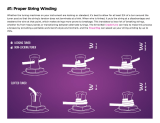
2
Taking Care of Your Instrument
Please follow the guidelines set out below to prolong the lifetime of your violin or viola.
Safety Tips
Please consider the following points of safety.
• To prevent contact, always maintain suf-
fi cient distance between yourself and other
people/objects when playing the instrument.
The shape of the bow is capable of causing
harm if care is not taken at all times.
• Be careful when transporting the instrument.
Make sure the instrument is handled with care
and is not subjected to any rough treatment,
like bumping against other objects or drop-
ping the instrument.
• Exposing the instrument and/or bow to certain
environments, particularly sudden changes
of temperature, may cause severe damage.
Please take the necessary precautions to pro-
tect your instrument against the following:
• Direct sunlight.
• Excessively high or low temperatures.
• Excessively high or low humidity.
• Excessive dust or strong vibration.
• Avoid leaving the instrument in a car for any
extended period of time. Extreme tempera-
tures, such as during the summer and winter
months, can be harmful to both the instrument
and bow.
• Make sure you regularly clean your instru-
ment with a soft, dry cloth. Never use ben-
zene, alcohol, or thinner. Never use aerosol
cans, or any other sprays, within the vicinity
of the instrument. These will damage the lac-
quer and general condition of the instrument.
• Prior to shipping the instrument has been ad-
justed and is ready for use. However, should
you feel that additional adjustments are need-
ed please contact your local Yamaha dealer, as
some alterations require specialist skills.
• Ensure that you loosen the bow hair before
you put it away in your case after playing.
• Plated parts such as the adjusters, metal
brackets on the neck support, etc., may tarnish
over time due to the makeup of the metal plat-
ing. This, however, will have no infl uence on
the performance of these parts. When tarnish
fi rst appears, cleaning carried out in normal
maintenance and care may be enough to re-
move the tarnish. (If the tarnish progresses
normal cleaning may not be suffi cient.)
• As the instrument and many of its parts are
made of natural wood, there may be some
cases, where objects that come in contact with
the wood (hands, parts of the body, cleaning
cloth, etc.) may become discolored. Color on
body parts is not harmful to your health but
you should wash and remove it with water.
We can not be held responsible for discolor-
ation of clothing, etc., or the discoloration of
the wood.
• If possible, hold your bow still when not in
use. Do not swing, throw or engage in any
other movements that could potentially cause
damage to other people/objects, or to the
bow itself.
• Take care not to pinch your hands or fin-
gers when closing the case.
This Yamaha violin is finished with a
high-quality oil varnish that is well suited
for the instrument’s acoustic characteris-
tics. As the oil fi nish is soft, high tempera-
tures and high humidity can soften the
fi nish further sometimes causing the cloth
inside of the case to stick to the violin (it
will not harm the violin’s performance or
durability). Please avoid storing the vio-
lin in places susceptible to high tempera-
tures and/or high humidity. Also, to keep
the instrument clean, use a soft cloth to
remove smudges and dirt after use.








